THE ROLE OF SCHOOL LIBRARY IN LITERACY DEVELOPMENT OF SCHOOL CHILDREN IN NEKEDE COMMUNITY IN OWERRI, IMO STATE
Keywords:
School Library, School Children, Literacy Development, Children Literature, Nekede Community, OwerriAbstract
This research examined school library and literacy development of school children in Nekede community in Owerri, Imo State. Five research questions guided the study. The study adopted survey research design. Population of the study comprised 200 students from two secondary school libraries in Nekede community in Owerri. A sample size of 120 school students was selected and used for the study. Mean and simple percentages were used to analyze the data collected. The study found that in the school library, available information resources that can promote literacy development of school children were story books , teen’s magazine, newspapers, video materials , and so on. The study found that these information resources could promote literacy development of these school children to a high extent . The role of school library in literacy development of school children is to teach literacy skills, promote independent learning, life- long learning. The school library achieves all these through book talk, creative writing activities, organising library week and book exhibition. The study also found that challenges that hinder literacy development of school children in these schools were poor funding , insufficient library materials, lack of current materials, poor library awareness and use of unskilled school librarian . The study recommended improved funding, provision of current and adequate reading materials, improved library awareness campaign and use of a skilled school librarian. Furthermore, the study recommends that attractive picture books and children literatures with bold characters should be procured for these school libraries.
Keywords: School Library, School Children, Literacy Development, Children Literature, Nekede Community, Owerri.
Introduction
Every educational process or knowledge acquisition begins with the ability to read and write. Simply put, literacy is the ability to easily read and write. Literacy as defined by UNESCO (2005), is the ability of a person to function in all the activities in which literacy is required for effective functioning of his/her group and the community and also for enabling him/her to continue to use reading, writing and calculation for his/her own and the community’s development. Literacy takes place when the reader understands what has been encoded. Literacy is considered a right, an essential and adds value to a person’s life. The building of a literate society will lead to the development and empowerment of children being able to understand their environment and institutions governing them.
School libraries are libraries in primary and secondary schools whose collections are mainly for the young. Library Research Service (2014) define the school library as a dedicated facility located in and administered by the school that provides at least the following: an organized, circulating collection of printed and/or audio visual and/or computer-based resources, or a combination thereof; paid staff; an established schedule during which services of the staff are available to students and faculty; instruction on using library materials to support classroom standards and improve student research and literacy skills. Apparently, the school library service is one of the crucial factors which facilitate implementation of the new educational policy and objectives by promoting the efficiency in reading culture of a child and general effectiveness of learning and teaching (Moruf, 2010). It provides an environment in which teachers can develop and update their knowledge and teaching skills. Students can also find materials to read which supplements and enrich what has been taught in class. School library also provides an independent means of education where users can work at their own pace to achieve their desired goals. Stressing its indispensability, Chima-James and Okoye (2006) reported that school libraries are established to prepare and train students for the challenges in the university education; therefore, to develop the literacy abilities of the students, there is need for a standard school library that have sufficient and available library materials.
Arua and Chinaka (2011) stated that school library materials are seen as all inputs which are utilized in the library in order to provide literacy with good reading habits and learning environment for students so as to be able to achieve educational goals. According to Fayose (1995), information resources in the school library include picture books, teens magazines and newspapers, films, computers, filmstrip, videotapes, recording of all types and so on. These variety of library materials are essential to facilitate the literacy development and good reading culture of the students. As part of its function, the school library is expected to thoroughly provide library materials necessary for the school’s educational programmes and to help in improving the literacy, reading skills and learning habits of students (Nyam & Guraj, 2009).
School libraries are expected to strive to collect and make accessible relevant and appropriate materials for literacy development. To meet this goal, instead of limiting access to resources within the physical entities, some school libraries take a proactive role to reach out to the underserved community children with literacy materials. For example, in Uganda a library book bike was used to deliver a selection of library books to trading posts, health centres and homes, with an aim to reach those children and community members residing further away from the village (Doiron & Asselin in Cheung & Waldeck, 2016). The Anchorage Public Library’s Ready to Read Resource Centre sent books, CDs, puppets and other literacy materials to child-care providers and families in isolated areas of Alaska (Howard, in Cheung & Waldeck, 2016). The Room to Read (RtR) classroom library model, which exists in eight countries (Cambodia, Sri Lanka, Viet Nam, Bangladesh, India, Lao PDR, Nepal and South Africa), supplied small collections of age and reading level appropriate books in the classroom. School teachers were trained on how to integrate these books into classroom activities and support recreational reading (UNESCO Bangkok, in Cheung & Waldeck, 2016). They further informed that teachers’ capacity in using literacy materials to promote literacy was also enhanced with the provision of training for them.
The success of these initiatives in providing literacy materials to support literacy development of children at home and schools in remote areas are good examples of effective partnerships with community institutions and NGOs (Howard, cited in Cheung & Waldeck, 2016). Other ways of making school library resources more accessible to the users include extending reading opportunities to students and children, as well as quality learning experiences for the children with direct access to literacy materials. Provision of books with appropriate reading levels and content relevant materials to the target groups is also important for effective implementation of literacy programmes for children (UNESCO Bangkok in Cheung & Waldeck, 2016).
In Nigeria however, the researchers observed that some school libraries have not been able to live up to expectation in literacy development programmes of school children to enhance their reading habits in school (Nyam and Guraj, 2009). They do not provide additional reading opportunities for students to improve their writing skills, increase their knowledge and clarity of expression which will in turn support children’s’ literacy development (World Bank, 2008). However, Busayo, (2011) revealed that inadequacy of relevant resources in school libraries have contributed to low level of literacy among the children, and this has in turn affected their reading culture and academic performance. This study examined the school library and literacy development of school children in Nekede community in Owerri, Imo State.
Statement of the Problem
Literacy is simply the ability to easily read and write. It is an essential skill aimed at empowering the modern man to succeed in life. It is also the bedrock for lifelong learning. The reading culture and literacy level of school children in Nigeria seems to be very low in recent times. From the researchers’ observation, this anomaly could be attributed to poor state of school libraries. Literature reviewed has shown that students hardly find relevant books of interest to read in school libraries. Experience in the country has also shown that some school library materials are not available whereas available ones are either not sufficient or obsolete for use by the students. Could this be as a result of poor funding of school libraries, insufficient and improper staffing, inadequate curriculum, poor students’ motivation, poor user education, inadequate processing of the library materials among others. Available studies on this subject have not shown school library and literacy development of school children in Nekede community in Owerri, Imo State hence this study.
Purpose of the Study
The main purpose of this study was to examine school library and literacy development of school children in Nekede community in Owerri, Imo State. Specifically, the study sought to
- find out information resources that are available in school libraries for literacy development of school children in Nekede community in Owerri;
- ascertain extent of use of available school library materials that can promote literacy development of school children in Nekede community in Owerri;
- determine the role of school library in literacy development of school children in Nekede community in Owerri;
- identify challenges school library face in promoting literacy development of school children in Nekede community in Owerri;
- determine strategies that will enhance literacy development of school children in Nekede community in Owerri.
Research Questions
This study sought to provide answer to the following questions:
- what information resources are available in school libraries for literacy development of school children in Nekede community in Owerri?
- what is the extent of use of available school library materials that can promote literacy development of school children in Nekede community in Owerri?
- what role does school library play in literacy development of school children in Nekede community in Owerri?
- what challenges face school libraries in promoting literacy development of school children in Nekede community in Owerri?
- what strategies would enhance literacy development of school children in Nekede community in Owerri?
Methodology
The study adopted survey research design. Population of the study comprised 200 school children from Eternal Word International School Nekede, and Federal Polytechnic Nekede Staff School. Stratified sample technique was used to select 120 students (60 from each) school from the two schools. Observation checklist was used to collect data for research question 1 while questionnaire was used to collect data for research questions 2 to 5. A total of 120 copies of each set of the instruments were distributed in the two schools out of which 100 completed copies were found usable. Data collected were analyzed using frequencies, percentages for research question 1. In the table, 1 stands for availability whereas 0 is the key for information resources that are not available. Mean scores was used for research questions 2 to 5. The questionnaire was structured on a four-point scale. The response category and weighting values are Very High Extent (VHE) = 4; High Extent (HE) = 3; Low Extent (LE) = 2; Not at All (NA) = 1. The decision rule for the mean score is 2.50.
Discussion of Findings
Table 1: Percentage of availability of i nformation resources in school libraries for literacy development of school children in Nekede community in Owerri?
Key: Available: 1; Not Available: 0
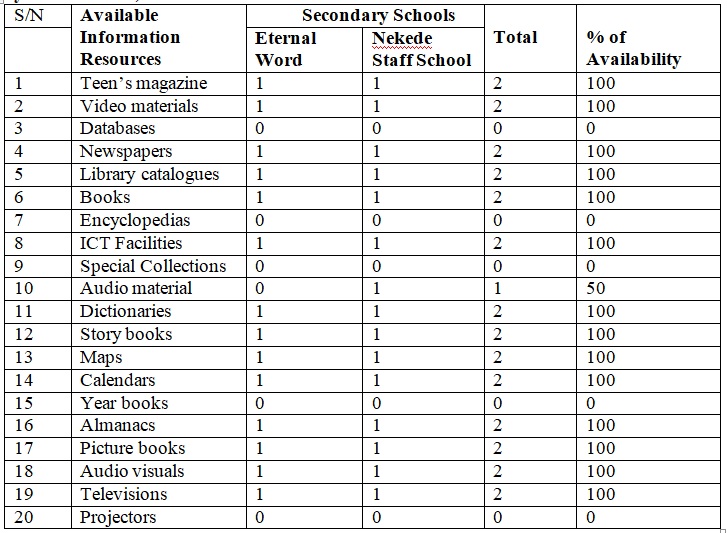
In Table 1, analysis of information resources that are available for literacy development of literacy skills of school children were presented. There are 20 items in the observation checklist used for the two schools in Nekede. From the analysis, Nekede Staff School has 15 of the listed items in its collection (teen’s magazines, video materials, newspaper, library catalogue, books, ICT facilities, audio materials, dictionaries, story books, maps, calendars, almanacs, picture books, audio visuals, and television). This accounts for 75% availability. Eternal Word School has 14 out of the 20 items listed (teen’s magazines, video materials, newspaper, library catalogue, books, ICT facilities, dictionaries, story books, maps, calendars, almanacs, picture books, audio visuals, and television) which accounts for 70% availability. The percentage of availability is an indication that these two schools have in their collection, information resources that can promote literacy skills development of school children in the selected secondary schools. However, the non-availability of reference sources such as encyclopedias and some e-resources raises some concern in this era of rapid technological development and information explosion.
Table 2: Mean ratings on extent of use of available information resources that can promote literacy development of school children in Nekede community in Owerri
KEYS: Very High Extent (VHE) = 4; High Extent (HE) = 3; Low Extent (LE) = 2; Not at All (NA) = 1.
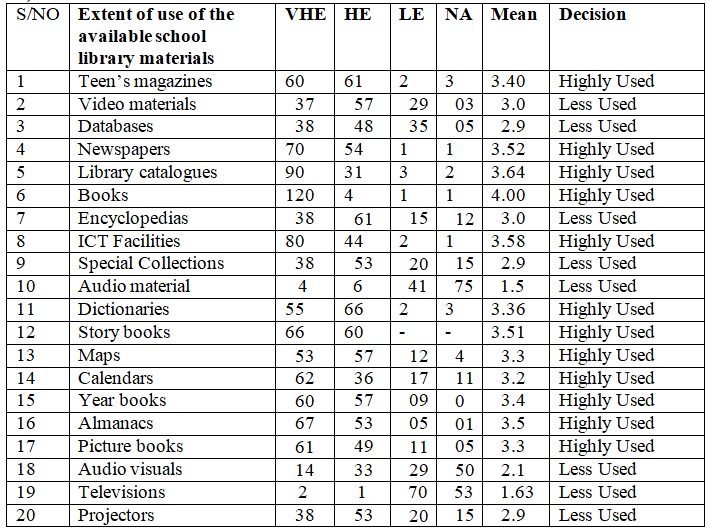
Table 2 shows extent of use of available information resources for literacy development of school children in the selected secondary schools studied. The analysis shows that teen’s magazine, newspaper, library catalogue, books, ICT facilities, dictionaries, story books, maps, calendars, yearbooks, almanacs and picture books were highly used. The analysis on less used materials is an indication that these children use only what is available to them. By implication, they are not at per with their counterparts in other schools where modern ICT resources such as databases, videos and so on are frequently used.
Table 3: Mean ratings on the role of school library in literacy development of school children in Nekede community in Owerri
Keys : Strongly Agreed (SA) = 4; Agree (A) = 3; Disagreed (D) = 2; Strongly disagree (SD) = 1.
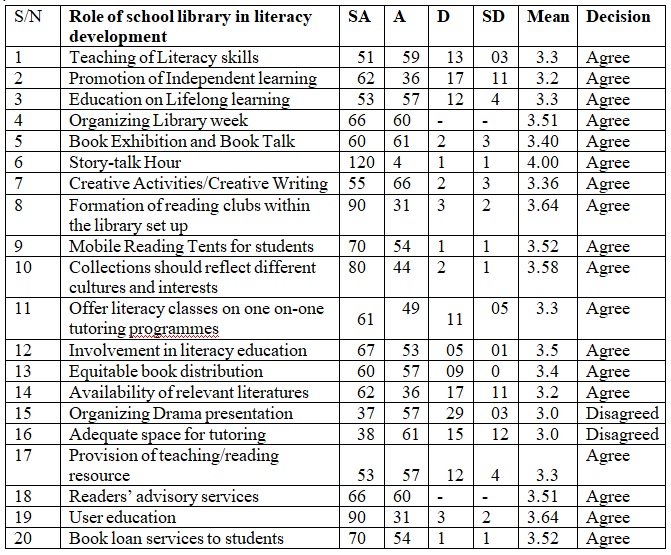
Table 3 indicates that the roles of school library in literacy development of school children are teaching of literacy skills, promotion of independent learning, education on lifelong learning, organizing library week, book exhibition and book talk, story-talk hour, formation of reading clubs within the library set up, mobile reading tents for students, creative activities/creative writing, collections reflecting different cultures and interests, involvement in literacy education, availability of relevant literature, provision of teaching/reading resource, readers’ advisory services, user education, offer literacy classes on one on-one tutoring programmes, equitable book distribution, and book loan services to students.
Table 4: Mean ratings on challenges that hinder literacy development of school children in Nekede community in Owerri
Keys : Strongly Agreed (SA) = 4; Agree (A) = 3; Disagreed (D) = 2; Strongly disagree (SD) = 1.
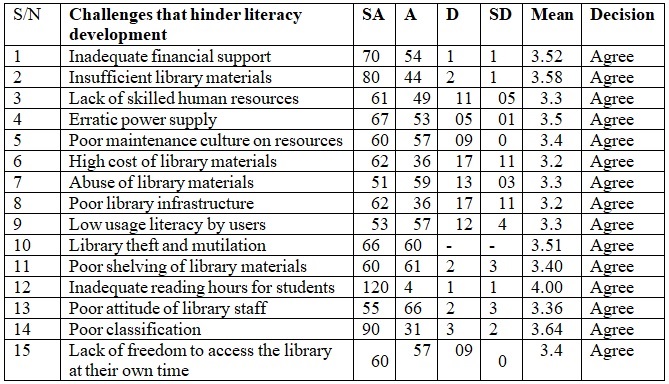
Table 4 indicates that challenges that hinder literacy development of school children are inadequate financial support, insufficient library materials, lack of skilled human resources, erratic power supply, poor maintenance culture on resources, high cost of library materials, abuse of library materials, poor library infrastructure, low usage literacy by users, library theft and mutilation, poor shelving of library materials, inadequate reading hours for students, poor attitude of library staff, poor classification and lack of freedom for students to access the library at their own time. Inadequate reading hours for students received a mean score of 4.00 indicating that these schools should restructure both their curriculum and school time table to create ample time for these children to develop reading culture and reading skills.
Table 5: Mean ratings on strategies that enhance literacy development of school children in Nekede community in Owerri
Keys : Strongly Agreed (SA) = 4; Agree (A) = 3; Disagreed (D) = 2; Strongly disagree (SD) = 1.
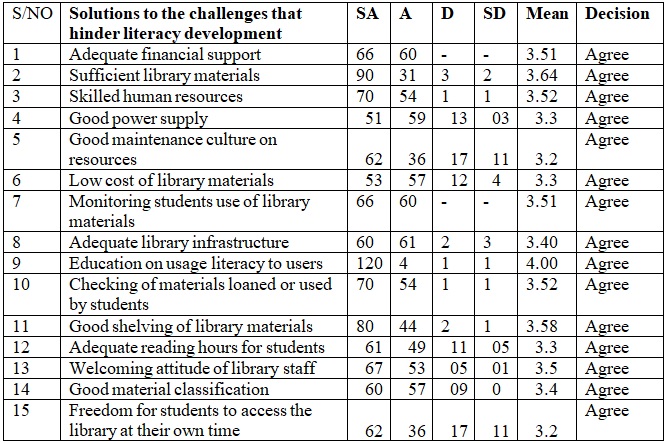
Table 5 indicates strategies that will enhance literacy development of school children in the two schools studied. These include adequate financial support, sufficient library materials, skilled human resources, good power supply, good maintenance culture on resources, low cost of library materials, monitoring students use of library materials, adequate library infrastructure, education on usage literacy to users, checking of materials loaned or used by students, good shelving of library materials, adequate reading hours for students, welcoming attitude of library staff, good material classification and freedom for students to access the library at their own time. Education on usage literacy to users received the highest mean score of 4.00. It is a serious indictment on the school library management. The two schools should as a matter of urgency build this into their curriculum to enhance literacy development of school children in these schools.
Conclusion
Based on the findings of the study, it was concluded that there is need for school libraries to provide sufficient library materials that can promote literacy development of the school children. This affects both their reading culture and literacy development. A child who fails to develop good reading culture from infancy has missed it in life.
Recommendation
The following recommendations were made based on the findings of the study:
1. Databases, Encyclopedias, Special Collections, Year books, and Projectors that were not available in Eternal Word and Nekede Staff School should be procured immediately.
2. There should be proper awareness on Video materials, Databases, Encyclopedias, Special Collections, Audio material, Audio visuals, Televisions, and Projectors that were less used so as to encourage the children to utilize them
3. The roles of school library in literacy development of school children should include restructuring of their school curriculum and time table to accommodate user education, organizing drama presentation and adequate space for tutoring so as to further improve the literacy skills of these children.
4. The challenges of inadequate financial support, insufficient library materials, lack of skilled human resources that hinder literacy development of school children should be given proper attention by the government.
5. Infrastructural development such steady power supply, equipping of school libraries and proper funding is sine quo non to literacy development of school libraries.
6. Monitoring students use of library materials, and adequate reading hours for students should be sustained in the school libraries so as to enhance literacy development of the children.
References
Agim, E. C. (2018). Awareness of entrepreneurial skills through library use by vocational education students in Nigerian Universities. Journal of Vocational Education and Research, 3 (1), 35-49.
Antwi, I. K. (2005). The reading habits and interest of secondary school students in Bauchi Metroplis: A case study. Nigerian Libraries 2 (2), 52-53.
Arua, U &Chinaka G, I., (2011). Use of library resources by staff and students of secondary schools in Umuahia North Local Government Area of Abia State. Journal of library Philosopy and Practice. Retrieved from http://digitalcommons.unl.edu/ cgi/viewcontent.cgi?article=1821&context=libphilprac
Ayaz, M., Ali N., Khan AB., Ullah R. &Ullah M. (2017) Impact of school library on students’ academic achievement at secondary school level in Southern Districts of Khyber Pakhtunkhwa. International Journal of Academic Research in Business and Social Sciences, 7, 5.
Busayo, I. O. (2011). The School library as a foundational step to children’s effective reading habits. Library Philosophy and Practice. Retrieved from http://unlib.edu/LPP
Cheung, E. & Waldeck, A. (2016). Literature Review: Literacy and Reading in Libraries (2011–2016). Written under the supervision of Lisa Krolak (Head of Documentation, UIL Hamburg).
Chima –James, N &Okoye, I. B. (2006). Materials of the secondary school libraries, vis-à-vis standards. Nigerian Library and Information Science Trend. 4 (1&2), 63
Edoka, B. E. (2000). Introduction to Library Science. Onitsha: PulmekPublishing,p. 15-16
Etim, F. E. (2007). The Evolution of the Information Society. In: Etim, F. E. and Nssien, F. U. (eds.), Uyo: Abaam Publishing Company, pp.15-25.
Fakomogbon, M. A., Bada, A. A., &Omiola, M. A., (2012). Assessment of school library resources in public secondary schools in Ilorin Metropolis. Interdisciplinary Journal of Contemporary Research in Business, 3 (10). Retrieved from http://connection.ebscohost.com/c/articles/77243791/assessment-school-library-resourcespublic-second
Fayose, P. O. (1995). School Library Resources Center for Educational excellence. Ibadan: Federal Ministry of Education.
IFLA/UNESCO School Library Manifesto (1999). Retrieved from www.ifla.org/publications/iflaunesco-school-library-manifesto-1999
International Federation of Library Associations and Institutions (2015). IFLA School Library Guidelines. 2nd revised edition. IFLA School Libraries Section Standing Committee, Netherlands
Joseph, K. (2003). What to know about library? Ibadan: Kay Jay Publishers,
Lianza (n.d) National Information Policy Position paper. Information literacy and literacy.
Makotsi, R. (2004) Sharing resources - how library networks can help reach education goals. Research paper commissioned by Book Aid International in 2004. p12 http://www.bookaid.org/resources/downloads/research-paper.PDF. Downloaded 10.1.2005
Montagnes, I. (2001) World Education Forum: Dakar 2000. Textbooks and learning materials 1990-99. Paris, UNESCO, 2001. 72 p., 4°.
Moruf, H. A. (2010). Use of School Libraries by Teachers and Students in Akinyele Local Government Area of Oyo State, Nigeria . Unpublished BLIS project, University of Ibadan.68pp.
Nyam, K.L & Guraj, S. (2009).The Role of Libraries in Encouraging Reading Habits in Students at Primary and Secondary School Levels. Technical Education Today.
Ogunseye, F. A. (2003). The library media factor in the implementation of the new secondary school syllabus. Nigerian School Library Journal . 3 (1 & 2), 1- 5
Rosenberg, D. ed. (2003) Reader Development and Reading Promotion: Recent Experiences from Seven Countries in Africa . Oxford, INASP, 2003. x, 86 p.
Singh, S. (2003) Library and literacy movement for national development. New Delhi, Concept Publishing. 269-280.
UNESCO (2005) Basic Learning Materials Initiative. http://www.unesco.org/education/blm/blmintro_en.php. Downloaded 11.2.2005.
UNESCO (2005). EFA Monitoring Meeting held in Dakar. Retrieved from http://UNESCO.org
Waite, J., (2009). The school library and GCSE. SchoolLibrary, 37 (4), 140
World Bank (2008). Textbooks and School Library Provision in Secondary Education in Sub-Saharan Africa,working paper No. 126
